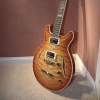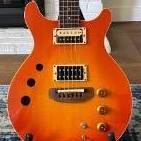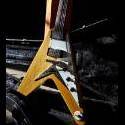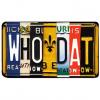-
Posts
1,090 -
Joined
-
Last visited
-
Days Won
2
Teh last won the day on September 21 2017
Teh had the most liked content!
About Teh

Previous Fields
-
guitars
2006 Newport Pro Custom, Fender: '22 Jason Isbell Tele, '15 60's Classic Strat, '14 50's Classic Lacquer Tele. Gibby Les Paul, Various others, Lots of Acoustics (Taylor/Gibson/Breedlove)
-
amps
Fender Tone Master Twin Blonde, Tone Master Deluxe Reverb Blonde
-
fx
too many...
Profile Information
-
Gender
Male
-
Location
Chicago Area
-
Interests
Getting through the day without frustration.
Teh's Achievements

Veteran HFCer (4/4)
827
Reputation
-

WTB Newport Pro with a Maple Top
Teh replied to mtn cub's topic in For Sale - Wanted to Buy - PIF - eBay & Other PSAs
Nice to meet you Mtn Cub - Best of luck on your quest to find the Newport of your dreams! -
Yikes! Cracked the top too?!? Oh, that sucks! On the good side, it looks like it pulled away cleanly. Should be a fairly straightforward repair - cleat the top crack , and install that moustache bridge you've always dreamed of!
-

WTB Newport Pro with a Maple Top
Teh replied to mtn cub's topic in For Sale - Wanted to Buy - PIF - eBay & Other PSAs
Looking inside the access door, you can see the little bump on the sidewall (Tailpiece support?) and the carved area on the Mahogany back. Removing the bridge pickup, you see the carved block just inside well in line to support the bridge and, assuming here, the tailpiece. The block is definitely there as shown in your pics. Whether it's the solid or carved out version, I can't say. Perhaps one of the old team can pipe in on this one. 🙂 -

WTB Newport Pro with a Maple Top
Teh replied to mtn cub's topic in For Sale - Wanted to Buy - PIF - eBay & Other PSAs
Alrighty, here's a quick rundown on this beauty - 18 years old as of last week! Measurements: Nut width is confirmed at 1.675". Neck depth at 1st fret - 0.875". Neck depth at 12th fret - 0.899". I guess I would call the neck profile a flat 'D' shape. Measured fretboard radius looks to be 14". Not chunky like my 50's LP, but comfortable to play and easy to get around. Body construction: Carved solid Mahogany back with 2 piece solid carved quilted Maple top, Jazzburst finish. Mahogany neck. Ebony fretboard with single Victory chevron at 12th fret. Bone nut. Quilted Maple headstock veneer with pearl logo. Italian Ivoroid binding with BWB purfling outline the body, fretboard and headstock. Ivoroid binding only on F holes Hardware: Seymour Duncan 'Seth Lover' pickups neck & bridge. TonePros bridge and tailpiece. Schaller Imperial tuning machines. Original hardshell case. 'Extras': This guitar was the grand prize for a contest sponsored by a teaching website, workshoplive.com, that I was lucky enough to win in early 2006. I could pick any guitar in the Hamer line up and work with Jol to customize as I desired. That brought about the specs above. I also flew out to New Hartford for a tour of the facilities and receive the guitar from Jol, Frank, and the entire crew. very cool experience! To sweeten the pot, Jol and team added a couple nice extras to the guitar to make it unique. Those extras included: Pickup coil split via push/pull tone pot. Back has full body carve like the front (Newports traditionally have a flat back). Another nice plus is the electronics access door in the back with matching Mahogany cover plate (see pics). I've never needed to use it as everything inside is original and untouched, but it is a cool conversation piece, nonetheless. The only change are the control knobs. The tone knob was starting to crack, so I replaced both of them with PRS lampshade knobs. The originals are in the case. Here are a few more pics of the details. It's really a killer instrument that can go from George Benson to George Lynch with no problem.- 44 replies
-
- 11
-

-

WTB Newport Pro with a Maple Top
Teh replied to mtn cub's topic in For Sale - Wanted to Buy - PIF - eBay & Other PSAs
That carve looks correct, Ben - Thanks for the pics. I'll take some detailed pics of the other details this evening and get them posted. -

WTB Newport Pro with a Maple Top
Teh replied to mtn cub's topic in For Sale - Wanted to Buy - PIF - eBay & Other PSAs
I'm not looking to move it but could be convinced at the right price. 2006 Newport Pro, custom built to my specs with some very special 'stuff' added by Jol & team. Was the centerfold in the last Hamer catalog (2006). It is a 60's carve neck but plays very comfortably. Seth Lovers with coil split via push/pull tone pot. Here's a quick pic. Can get you more if interested.- 44 replies
-
- 11
-

-

Anyone tried the Keeley Muse Driver?
Teh replied to Saul Goodman's topic in Hamer Fan Club Messageboard
Own it. Love it. -
Feeling like a little tele twang today. Went for Brad Paisley's "Play"...
-
My gawd, there's some beautiful instruments on these pages. I'm sorry that this body style is not my cup of tea, but there's no doubt the craftsmanship on these guitars is incredible. I can't wait to hear that Mike is offering something in a semi hollow or single cutaway design - I'll be all over that like white on rice...
-
A set of Fender CS '69 Strat p'ups, a book on the history of Gibson Lap Steel guitars (I didn't know Gibson even made lap steels), and a Squier CV Thinline Tele that I drunk bid on last Saturday night and ended up winning on Monday (surprisingly good sounding and playable for the price).
-
I get where you're coming from on this. That's my attitude on acoustic guitars, as that's where I spend 85% of my time performing live - on acoustic. My Newport falls into this category too. I think I get as much enjoyment - if not more - out of the physical act of digging into an electric's guts, learning what makes it good/bad. Learning the different wiring options; why a 0.047uF cap is better than a 0.022uF cap; how noiseless single coils perform against standard models and what impact vertical position has on the tone; is there a real difference between solid core wire and stranded wire, etc. All that minutiae that most people really don't give a rat's ass about. I also love setting up the same instruments, getting intonation and action set as close to perfect as possible - Anything I can shove a screwdriver or allen wrench into. At the end of the day, if I screw it up completely I'd rather do it on a guitar that wouldn't break my heart if I have to gut it and start over or completely scrap altogether. It's a learning process, a stress release and a lot of fun. The beauty of a manufactured guitar (a'la Fender) as compared to a crafted guitar (a'la Hamer) is the manufactured guitar is designed for ease of assembly. That means it's also designed for ease of dis-assembly. By effectively reverse engineering and experimenting, I feel like I'm gaining a better understanding of the instrument. my ultimate goal - once life settles down and the kids are gone - is to try my hand at building acoustic guitars. The plan is to start with a kit or two (Stew-Mac or Martin both make nice ones). That will probably scratch the building itch fine. If it doesn't, then there are seminars to attend and enough room in the basement to start a small workshop to try building from scratch. There are no delusions of becoming the next Bob Taylor - I just hate watching TV, so I need something else to fill time...
-
I enjoy the process of finding budget guitars that have good bones then giving them a facelift in the electronics department. A standard upgrade on all changes below is new electronic hardware -- Pots, switches, jack, and wiring. Quality does make a difference... . IMO, Strats were designed for pickup experimentation. I have a half dozen pickguards in the parts closet in various stages of disassembly. Tried Lace Hot Golds with and without the Clapton mid-boost and TBX set up. Briefly had a Fishman X-Bridge acoustic set up (sounded like crap to my ear - very short lived). Did Tex-Mex too (too brash). My current set up is 57/62's on a Maple fretboard MIM (love these!) and SCN's on a Maple fretboard American Standard. I like the SCNs okay, but am itching for something different, so the plan is to swap these with the CS 1969's before the end of the year. I picked up a great playing Squier Tele last year cheap, and immediately swapped out the lousy standard issue electronics for SD Tele classics. Major difference. Picked up a new Epi Les Paul Standard Pro II a couple years back. While the standard issue pickups were an improvement from their previously standard mud buckets of years past, I really like the transformation that happened with the oft-used Duncan JB/Jazz combination. This one got the addiitional benefit of the Jimmy Page wiring for coil split and phase reverse via pull-pots. The most recent project was a Washburn J9 thin hollowbody with a 16 inch lower bout and Bigsby. A Gretsch County Gentleman knock off. I wanted to go with Filtertrons, but it would have cost more than I paid for the guitar. So, instead I went with GFS clones -- Liverpool in the neck and Memphis at the bridge. Though not as twangy as the real Filtertrons, I'm happy with the result. I also learned that rewiring the hardware in a hollowbody without an access door is a real PITA. Don't want to do that again any time soon. Frankly, the only electrics in the herd that haven't been modified are my Newport with Seths (Why mess with perfection?) and a Taylor T5. The T5 did get new Gotoh 510z tuning machines (21:1 ratio -- Smooooth...). I did the same for my acoustics -- they make a big difference in tuning accuracy. At the end of the day, all of these cheap guitars & changes cost less than a single new LP. Lots of "new" tone and keeps me out of trouble with the wife.
-
Playing acoustics with .13's all the time make electrics with .09's unplayable for me. I like '11's just fine but, to paraphrase Mark Knopfler, I'm "Strictly rhythm - I don't want to make it cry or sing"...
-
I use 0000 steel wool on the fretboard -- cleans up the gunk and puts a shine on the frets. Go with the grain. A little credit card action right at the frets to scrape up the crap right at the frets. A little lemon oil or mineral oil on a rag to clean up residue and give the fretboard a fresh look. Don't drown the board in oil -- A little goes a long way. As for polish, I use Virtuoso polish on the lacquer finished ones, and Turtle Wax Express Shine on the UV cured poly finish. Never use Pledge or other polishes with silicone as it will cause problems if you need to do finish repairs.





.jpeg.2e21f64f728b56b8d9f4e98dfe9aac14.jpeg)
.jpeg.7e58f3b5a2ed3dcc38e176e4def9619c.jpeg)
.jpeg.6e7696244e4e7284fffd33994d07c830.jpeg)
.jpeg.f22bcbed8e0b571d1156d5f22a98fbdf.jpeg)
.jpeg.db99b3367a28e8eb3f1637a7dfb06280.jpeg)
.jpeg.f40aa18cf72c178e0f79106214e0054a.jpeg)
.jpeg.0e2848a4ce3cecb34dca1e6dcfeaaa3c.jpeg)
.jpeg.520b808c6eb79e66a00ac3832342af22.jpeg)

